 |
|

|
 |
TABLE of CONTENTS
 |
Mississippi River shipping season closes |
By Sue Roe

The towboat William Kimble pushes barges into the port of St. Paul. In the background is the city of St. Paul along Warner Road and the Lafayette, Robert Street and Wabasha bridges. Photo by David Gonzalez |
The 2013 Mississippi River shipping season came to its official end Nov. 28 when the towboat Ginger Griffen New departed St. Paul Park, Minn., pushing two liquid asphalt barges southbound through Lock Two at Hastings. Just two days earlier, the towboat Wisconsin left St. Paul, pushing the last six barges of grain products down the river.
The season lasted 233 days this year, less than the average of 250 days, according to Dick Lambert, Ports and Waterways Section director. The season got a late start due to cold temperatures and high water last spring.
Lambert said preliminary reports show total tonnage is down from the previous year. In 2012, 10.7 million tons of products came in and out of the state’s five river ports. While Lambert is still receiving final figures, he estimated this year’s tonnage will be closer to 9.5 million tons.
The main outgoing product is grain and in 2012, 4.4 million tons of grain shipped south, compared to 4.6 million tons in 2011. In 2003, 7.5 million tons were shipped. Most of the grain shipped is corn, but soybeans and wheat are also shipped in substantial quantities.
Grain shipments down the river have gradually decreased over the years because more products are going to Asian markets via west coast seaports and more of the state’s corn is going into ethanol production. Minnesota shippers choosing to move commodities to Asian ports via rail through the West Coast generally will pay less than shipping down the Mississippi and through the Panama Canal to these same Asian ports, Lambert said.
Ethanol plants use corn to make ethanol and a cattle feed byproduct called distiller dry grain, which can be shipped via the river to domestic and foreign markets.
The shipment of non-grain commodities has remained fairly stable, Lambert said. Inbound commodities include sand, gravel, fertilizer, cement, salt, coal, steel and caustic soda, while outbound products include scrap iron, asphalt, potash, frac sand and petroleum.
Although the river ports are closed for the winter, the state’s four Great Lakes ports remain open until Jan. 15. Products coming into Minnesota ports include cement, salt, fertilizer, limestone and general cargo, all of which amounted to 4.8 million tons in 2012. Of the 56 million tons exported from Minnesota lake ports in 2012, taconite, from the state’s Iron Range, amounted to 41 million tons. Grain and coal made up the remaining tonnage.
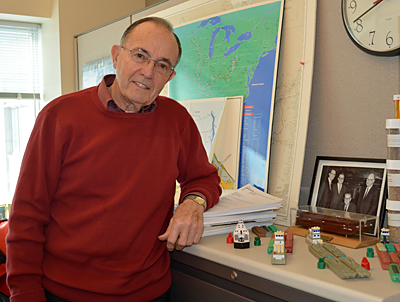
Dick Lambert has been MnDOT’s director of ports and waterways for 21 years. He often uses these models of barges and towboats to explain waterway transportation, which is an integral part of the state’s multimodal transportation system. Photo by Sue Roe |
Lambert said MnDOT would like to see more freight shipped on waterways because it lessens wear and congestion on the roadways.
“Moving freight by water is more fuel efficient with fewer emissions and is cheaper than rail or truck,” Lambert said. “Our new Ports and Waterways Study shows the economic value of waterways to Minnesota. This is the first time we’ve done a study just on waterways and it shows, among other things, that the more freight we move on the water, the less congestion we’ll have on our roads and the more economic growth we’ll see.”
|
 |
|

|
 |
TABLE of CONTENTS
 |
District 2, 4 announce management selections |
By Rich Kemp

Craig Collison is the district engineer in District 2, which serves 14 counties in northwestern Minnesota. Photo courtesy of
District 2
|
Several management positions were announced recently in Districts 2 and 4, including a district engineer, assistant district engineers and a program development manager.
District 2
Craig Collison has been selected as the district engineer in District 2 after serving as acting district engineer since May 2012. He has been with MnDOT for the past 29 years, 24 of those years in District 2.
A native of Hines, Minn., Collison earned his civil engineering degree from North Dakota State University. He resides in Bemidji with his wife, Becky, and has four grown children.
The district has 17 truck stations and three regional offices throughout 14 counties in northwestern Minnesota.
“Craig brings an excellent background in program delivery to the district engineer position that will be key in helping us enhance financial effectiveness,” said Mike Barnes, Operations Division director. “He has developed great working relationships with our northwestern Minnesota transportation partners and communities.”

Jim Curran is the assistant district engineer for program delivery in District 2. Photo courtesy of
District 2 |
Jim Curran has been named assistant district engineer for program delivery in District 2. Curran served in an acting role since June 2012 and has been with MnDOT for more than 25 years. He has previously held roles with construction, design, surveys, materials, bridge, right of way and maintenance operations.
A native of Aitkin, Minn., Curran earned his civil engineering degree from North Dakota State University. He will oversee the traffic, materials, project management, design, right of way, and contract administration of the district’s construction program.
“Jim has years of experience in maintenance and program delivery within the district,” said Barnes. “That will be important in supporting our department project management efforts.”
J.T. Anderson was named assistant district engineer for maintenance operations in District 2. Anderson served in an acting role since June 2012 and has been with MnDOT for more than 17 years. He also worked at the Missouri Department of Transportation and has experience within the planning, materials and construction sections.

J.T. Anderson is the assistant district engineer for maintenance operations in District 2. Photo courtesy of District 2 |
A native of Hallock, Minn., Anderson earned his civil engineering degree from North Dakota State University and holds a master’s degree in civil engineering from the University of North Dakota.
Working out of the Crookston headquarters office, Anderson will oversee the district’s field operations, bridge, signs, Crookston permits, and fleet functions.
“J.T. is an excellent project manager with a solid background in construction and maintenance that will be valuable experience to bring to his new role and to support our asset management efforts,” said Barnes.
“Jim and J.T. have a combined 37 years of transportation experience which is beneficial as we continue to provide first-rate service to the public in northwestern Minnesota,” said Collison. “Jim has a great understanding for the region; he built his experience across a variety of departments and districts. J.T. has a very important role in both District 2 and statewide. As an avid outdoorsman, he brings great perspective to the challenge.”
District 4
Shiloh Wahl was selected as the District 4 assistant district engineer/program development manager. Wahl has been with MnDOT for nearly 14 years. He graduated from the South Dakota School of Mines and Technology with a degree in civil engineering.

Shiloh Wahl is the District 4 assistant district engineer/program development manager. Photo courtesy of District 4 |
Wahl started his career with District 4 in January 2000, where he rotated through several areas as a graduate engineer. In May 2001, he started as a project engineer and worked on various construction projects, including the Hwy 336 project near Moorhead and the Hwy 10 “Connect Detroit Lakes” project. He also served as the District 4 planning director. For the past two years, he was on mobility as the program development manager and also was the project manager of the Jurisdictional Realignment Study.
“Shiloh will oversee the planning, project development, right of way, surveys and the newly created dedicated project managers,” said Jody Martinson, District 4 district engineer. “This is a very important role for District 4 and provides important services that directly impact the citizens of this region.”
|
 |
|

|
 |
TABLE of CONTENTS
 |
Accessibility tips – Part 2: Creating PowerPoint presentations |
By Becky Dahlberg

Templates have been preformatted to help make MnDOT PowerPoint presentations accessible to everyone. |
Do you create PowerPoint presentations? Then these tips are for you. Keep them in mind as you’re creating your next PowerPoint and you’ll have a presentation that’s accessible to everyone, whether you’re speaking in front of folks at a meeting or distributing it to others to view on demand.
- Start with a MnDOT template. MnDOT PowerPoint templates are branded and preformatted with high contrast color combinations for maximum visibility. The dark blue background option is best for presenting in large rooms, while the white background option is best for small rooms and for printing. Download a fresh template from the templates and logos page and you’re already halfway to making your presentation accessible to everyone.
- Ensure all slides have unique titles. Slide titles are used for navigation and selection by people who aren’t able to view the slide. Don’t forget to add a title to each slide in the title box – preferably one that describes the content of the page or section at a glance. If you don’t want a title to be visible on consecutive slides, just follow Microsoft’s directions on adding invisible titles.
- Add alternative text to images and objects. Alternative text, or alt text for short, appears when you move your pointer over a picture or object, and helps folks using screen readers understand the content of images in your presentation. You should add alt text to things like pictures, clip art, shapes and charts, and it’s easy to do. Simply right click on the image or object and click “format picture,” where you can enter a title and description. The title and description can be brief or extensive as needed, depending on the complexity of the image or object you’re describing. Note: alt text is really only necessary if you’re planning to distribute your PowerPoint via email or post it on ihub for others to download or view on demand. If you’re only presenting it in front of an audience, alt text is not needed.
Don’t forget that PowerPoint is meant to be used for presentation purposes only. There are many other methods of communication (including fact sheets, brochures and the web) for other needs. Contact the Communications office anytime to explore your options or for any guidance on the best approach.
For more PowerPoint accessibility tips, visit http://ihub/communications/adaweb.html. Watch for part 3 in the next issue of Newsline! |
 |
|

|
 |
TABLE of CONTENTS
 |
Annual Freight & Logistics Symposium held in Minneapolis |
|
By Sue Roe
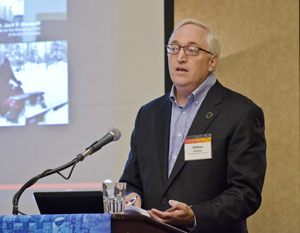
Bill Gardner, Office of Freight and Commercial Vehicle Operations director, spoke at the Freight and Logistics Symposium on freight’s connection to Minnesota’s economy. Photo by Mike McCarthy, University of Minnesota |
The 17th annual Freight and Logistics Symposium drew public, private and academic professionals to Minneapolis in December to discuss strategies to maintain the existing transportation infrastructure in the state and region. The Center for Transportation Studies at the University of Minnesota hosted the event and MnDOT was one of five co-sponsors.
Theme for the symposium was the Gravity of Logistics: Building an Economy Conducive to Growing Business.
Rosalyn Wilson, senior business analyst at Delcan Corporation, Tysons, Va., was featured speaker. Wilson is author of this year’s State of Logistics Report, published by the Council of Supply Chain Management Professionals. The annual report is widely used by supply chain management professionals as the premier benchmark for logistics activity in the country.
The report includes perspectives from Bill Gardner, MnDOT Office of Freight and Commercial Vehicle Operations director, on freight’s connection to Minnesota’s economy.
Jon Huseby, District 8 engineer, moderated a panel of experts about the supply chain in the public and private sector. Panel members were Frank Douma, Humphrey School of Public Affairs at the University of Minnesota; Meg Duncan, Koch Logistics; and Tim Thoma, Northern Tools and Equipment.
Another panel, moderated by Jason Craig of C.H. Robinson Worldwide, Eden Prairie, Minn., discussed supply chain challenges and the implications for the transportation system. Panelists were Chip Smith, CEO of Bay and Bay Transportation; Randy Brown, vice president of transportation and logistics at Cargill; and Louis Jambois, president of St. Paul Port Authority. |
 |
|

|
 |
TABLE of CONTENTS
 |
Vlaminck family provides more than 150 years of public service to MnDOT |
By Judy Jacobs
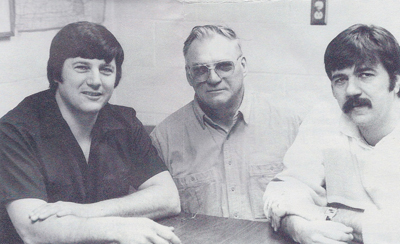
In this 1989 MnDOT newsletter photo, Lucien Vlaminck (center), and two of his sons, Joe (left) and Jeff, were featured in a story about District 8. Lucien and his four sons have provided more than 150 years of public service to MnDOT. MnDOT file photo |
When Lucien Vlaminck accepted a job in landscape maintenance with MnDOT in District 8 in 1967, he had no idea of the family legacy he was beginning.
Lucien was one of two landscapers hired to work under President Lyndon B. Johnson’s Highway Beautification Act. The legislation was the pet project of the first lady, Lady Bird Johnson. She believed cleaning up city parks, planting flowers and screening junkyards from view would make the nation a better place to live. Lucien shared that enthusiasm about taking care of plants and the environment. His passion for his job soon spilled over into his family life.
Lucien’s son, Jeff, was the first son encouraged by his dad to pursue his interest in drafting and design. He was hired in the former District 5 (part of Metro District today) in 1977 as a highway technician/inspector and worked on such projects as the Interstate 94/494/694 interchange near Fish Lake Road and on the Highway 100 – 77th Street project to Crosstown. In 1985, Jeff began working in Preliminary Design while attending the University of Minnesota to earn his civil engineering degree. Grad rotations gave him the opportunity to explore career options in soils, right of way, design and hydraulics.
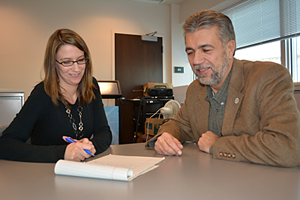
Kristin Kammueller, District 6 public affairs coordinator, discusses district events with Jeff Vlaminck, district engineer. Photo by Rich Kemp |
“MnDOT provided me with a lot of great opportunities in a number of locations and positions,” said Jeff. He was promoted to district engineer in District 6 in February 2013 and has almost 37 years of state service.
Son Joe was the next Vlaminck to enter state service. Prompted by his dad, Joe accepted a job in the former District 9 in 1978 as a heavy equipment mechanic apprentice. He worked in the Oakdale office during his two-year apprenticeship and transferred to District 8 in 1981 as a heavy equipment mechanic. He was promoted to a heavy equipment field mechanic in 1995. Joe is quick to note that not only was his dad a recruiter for MnDOT within his family, he also was the first to mention state employment to others.
“Dad would always tell people they should work for the state and he would offer to pick up a job application for them,” said Joe, who will soon celebrate 36 years with MnDOT.
Son Jesse took a different route to state employment. In 1983, he began working at the Willmar Regional Treatment Center, formerly Willmar State Hospital, as a human service technician. Downsizing at the regional center caused Jesse, with his dad’s encouragement, to take the highway maintenance worker and technician tests. Jesse was hired at the Olivia Truck Station in District 8 in 1998 and worked there for six months before transferring to Detail Design in Willmar, where he now works as an engineering specialist.
“MnDOT has been generous in sending me to work-related training,” said Jesse. “And the people here are great! You can learn so much from them.” Jesse celebrates his 30th anniversary of state service this month.
A fourth son, Jon, graduated from St. Cloud Tech with a civil engineering technology degree and began working in District 9 in 1989 as a highway technician/ bridge inspector. He transferred to District 8 in 1996 to Preliminary Design. That same year he became an independent insurance inspector for District 8 in Willmar. He also is a volunteer snowplow operator for the district. Jon has 24 years of state service.
The four brothers agree that their dad is proud they followed in his footsteps.
“Dad always wanted better for us than he had,” said Jeff. Jesse added, “We thank Dad for pushing us to better ourselves.”
Lucien’s support and encouragement extends to his 22 grandchildren and four great-grandkids, as well.
Lucien Vlaminck retired in 1995 with 29 years of service in District 8. His thought on his family’s service to MnDOT?
“I guess it’s just kind of a nice thing.” |
 |
|

|
 |
TABLE of CONTENTS
 |
On the Job: Meet Dan Flatgard, GIS jack-of-all-trades |
|
By TK Kramascz
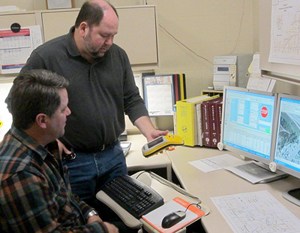
Dan Flatgard (standing) provides support to District 7 Traffic Asset Manager Tom Brooks as he works on the D7 sign inventory. Photo by Rebecca Arndt |
Dan Flatgard always seems to be on the move. And it’s no wonder. With his knowledge, skills and abilities in the highly technical and rapidly expanding world of Geographic Information Systems, he’s the one you’d call if you needed a project kicked off, consulted upon or wrapped up correctly.
GIS is a relatively broad term that can refer to a number of different technologies, processes or methods. It is attached to many procedures and has many applications, from engineering, planning and management to transport/logistics, insurance, telecommunications and business.
In a nutshell, describe your office’s basic responsibilities and your specific ones.
I was initially hired into the Transportation Data and Analysis office, which has now been incorporated into the newly created Office of Transportation System Management. My role in this position is to provide statewide Geographic Information System support, which includes answering technical support questions from employees who use GIS, developing maps for a variety of MnDOT areas, such as maintenance, traffic, program delivery, environmental stewardship and planning. I also provide GIS/GPS training to the statewide districts and offices. My position is assigned to Central Office, but I work wherever I’m needed. I spent time this summer working out of Central Office and District 3 in Baxter, and I currently reside in District 7 in Mankato.
What’s your background?
I began working with District 7 in the Windom Surveys and Construction office performing construction and location surveys and construction inspection during the summers while I attended college. After working in the Windom office for five years, I transferred into the District 7 preliminary design unit in Mankato, primarily developing geometric layouts and profiles and displays and maps for public meetings. During this time I returned to college to learn about GIS and how I could use it in my job. I attended Minnesota State University for my undergraduate and graduate studies and supplemented this education by taking a few online graduate courses at Northwest Missouri State University. I left MnDOT to pursue other opportunities, which helped me acquire new skills, which I’m able to use in my new position. I am excited and happy to be back on board with MnDOT, and I look forward to working with everyone.
What are you working on right now?
I’m working on a variety of projects, such as GPS technology curriculum development; project delivery maps for public display; traffic asset mapping, specifically for signals, lighting and striping; maintenance activity mapping, such as pavement condition and snow trap location mapping; and answering support calls throughout the day.
What does a typical day look like?
I typically have projects in different stages at any given time, so communication and scheduling with others is important. The projects I work on I acquire from others, so I spend time teleconferencing with those around the state as I work on their projects. Additionally I receive email and phone calls from GIS users needing assistance with software or equipment. Being in a support and production position can be challenging, and it’s important to continually communicate with those I’m working with to help prioritize my workload.
Is there a busy time of year?
I typically don’t have a busy time of year, as GIS activities are ongoing every day. My position relies on the requests of others, so I am happy to take on new projects.
What other challenges do you face?
The position I’m in is a shared services position, meaning I get paid by those who I work for. This is a new position concept, so we’re still working out the bugs. If I work for a specific district or office, I am required to use their funding numbers to use in RCA. This has been challenging at times, as budgets are being watched closely.
What’s most rewarding about the job?
The most rewarding aspect of my job is helping others develop and complete their projects. I enjoy using technology to solve problems. It is rewarding when we work as a team to converge on a common goal and complete a challenging project.
What’s your favorite part of the job?
The favorite aspect of my job is working with all the great employees we have here. I’ve had the opportunity to meet new people and reacquaint myself with people I haven’t worked with in some time. I also enjoy seeing the progress we are making as an organization with the use of GIS technology to help us deliver and meet our business needs. I won’t profess that I know everything about GIS, but I’ve been around long enough to know whom to call for answers. We have a lot of talented GIS staff here at MnDOT, and a great working relationship with our MnIT partners, which makes my job easier if I ever have questions when taking a support call or working on a challenging project. |
 |
|

|
 |
TABLE of CONTENTS
 |
MnDOT receives Asphalt Paving Awards |
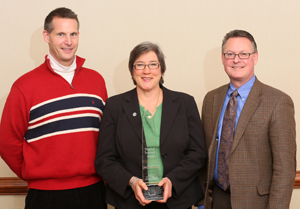
From left, Mark Panek, District 6, and Sue Mulvihill, deputy commissioner/chief engineer, received the National Perpetual Pavement Award for MnDOT from Mike Kvach, Asphalt Pavement Alliance Dec. 11. Photo by Minnesota Asphalt Pavement Association |
During the Minnesota Asphalt Pavement Association's annual meeting Dec. 11, MnDOT received several awards. MnDOT received a record 11th National Perpetual Pavement Awards for a portion of Hwy 61 in District 6 in southern Minnesota. Accepting the award for MnDOT were Mark Panek, District 6, and Sue Mulvihill, deputy comissioner/chief engineer.
The criteria for this prestigious national award are pavement sections that are 35 years or older, have not had major structural failure, have on average at least 13 years between overlays, and should demonstrate excellence in design, quality in construction and value to the traveling public. From 2001 to today, the APA has presented 85 Perpetual Pavement awards. The awards recognize that many well-built asphalt pavements have been in service for decades with only minor periodic surface rehabilitation.
The award winning Hwy 61 project (from milepost 34 to 53) is an example of design and endorsement of long-life, perpetual asphalt pavement in Minnesota. Thanks to the progressive vision and partnering efforts of agency and industry representatives, this project has demonstrated outstanding design, construction, and performance value for 43 years of service to the traveling public of Minnesota.
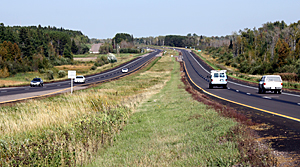
The Asphalt Paving Merit Award for Resurfacing a Low Traffic Roadway was awarded to MnDOT for the Hwy 33 project in District 1. Photo by Beth Petrowske |
MnDOT also received the Asphalt Paving Merit Award for Resurfacing a High Traffic Volume Roadway for work on Hwy 212. Receiving the award on behalf of MnDOT were Paul Methven, Mulvihill, Kiet Ly and Jay Koski.
Hwy 33 in District 1 received the Asphalt Paving Merit Award for Resurfacing a Low Traffic Roadway. Receiving the award for MnDOT at the ceremony were Jennifer Berry, Jason Abernathy, Brian Larson, Nadine Miller, Linda Pearson, Duane Hill, Steve Keith and Mulvihill.
|
 |
|

|
|

|
 |
TABLE of CONTENTS
 |
Employees share their expertise, generosity for benefit of all Minnesotans |
By Commissioner Charlie Zelle
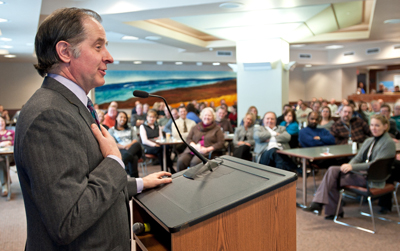
Commissioner Charlie Zelle speaks to Central Office employees earlier this year. Photo by David Gonzalez |
As the holiday season surrounds us, I think it is important to take stock of what we have and where we are going.
About a year ago, I was introduced as MnDOT’s commissioner. And it has been a very interesting 12 months. I’ve learned much about this great agency and about the strong employees who make up its workforce.
Some of the things I’ve learned:
- You are a giving group. I know that there are fundraisers and community support efforts in MnDOT districts and offices across the state. For example, the Metro District recently provided a snowplow’s worth of holiday gifts to Toys for Tots and Central Office delivered more than 400 pounds of non-perishable goods and made cash donations to the Second Harvest Food Bank, to name a couple of efforts.
- You are a proud group. Last winter, I caught a ride on a snowplow from the Golden Valley truck station. The operator introduced me to plow operations, clearly taking a great deal of pride in his work and the work of his shop. I also found out that operating a plow is a pretty challenging task, particularly when you add traffic to the mix!
- You are a group with many talents. Earlier this month, as I was sitting in my office, I was surprised to hear the sound of Christmas carols floating through the air. I followed the sound and discovered the MnDOT choir in the elevator atrium, entertaining the floor. It was a beautiful set of songs, and I greatly appreciate their musicianship and the cheer they brought to all of us who had the pleasure to hear them.
- You are tremendous public servants. I have been traveling around the state, talking about transportation funding and the future. This has allowed me to visit many towns and cities in Greater Minnesota. I have been impressed with the strong relationships MnDOT has built with local officials and communities. And I appreciate how hard you all work to make sure those who use transportation get the best system possible.
- You are skilled professionals. In the past year alone, MnDOT has won numerous awards for its leadership, planning efforts and projects. I can’t tell you how proud I am when I travel to national meetings and hear from my peers what an outstanding job MnDOT does. This is because of you—your knowledge, your expertise, your collaboration. You make our agency—and Minnesota—look great.
I am exceedingly proud of the fact that I am working with this great agency. You are, without a doubt, the best, most dedicated, state employees. Minnesota is fortunate to have all of you attending to its transportation needs.
So, thank you for all you do. I hope the holidays bring you great joy as you gather with your families. And I look forward to working with you in the coming year. |
 |
|
| |
|



